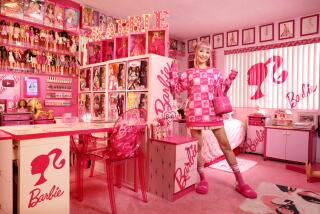Good Clean Fun
- Share via
There is a growing movement among toy manufacturers and, like most trends in this $20-billion business, if it catches on, the next Han Solo action figure might be battling streptococci and the Caped Crusader could be on the prowl for alternative fuels for the Batmobile. Call it green and clean.
While toy companies have long touted safety in their wares, some are now actively raising the possibility that microbes might enter the house on the cute red hairs of your child’s favorite doll and are responding carefully to the toy-buying public’s consciousness about safety.
Witness the worry last Christmas over the Cabbage Patch Kids Snacktime doll that, if prodded incorrectly, could chew on a child’s hair. The story got widespread coverage. Yet fewer than 100 incidents, none requiring hospitalization, were reportedly associated with the more than 500,000 dolls sold. Nonetheless, Mattel decided to offer doll-buyers their $40 back to ward off any further bad publicity.
“The fact that many toy purchasers are aging baby boomers, who are concerned with their own health, contributes to this consciousness of health and safety in toys,” said professor David Stewart, chair of the Marketing Department at USC. “Add to this the media attention given to health and food and safety concerns, and you can see why today’s parents are worried a bit more about this when buying toys than my parents were.”
Actually, based on the U.S. Consumer Products Safety Commission safety statistics, reported injuries associated with toys were down 10% from 1994 to 1995, when 150,800 injuries were reported. Further, only 1% of the 1995 injuries required hospitalization, down significantly from an average of 4% over the previous four years. The commission reported 21 deaths associated with toys, including eight from choking on balloons and four from being struck by cars while riding bikes. None was directly attributed to the toy itself, but to accident or misuse.
On the health front, Playskool, the toddler brand name of Hasbro Inc., the nation’s second-largest toy company, is in the vanguard of the antimicrobe wave. Much of its line this year will be infused with a substance called Microban, which breaks down cell walls of bacteria so they cannot reproduce.
“We are not actually marketing health,” said Anna Dooley, vice president for marketing for Playskool, who added that Playskool will spend much of its marketing money this year promoting Microban. “We’re just offering antibacterial protection on toys. It’s just an additional tool that you now have to limit a child’s exposure to disease. All of our testing says this is a benefit parents want.”
But Dooley said Microban’s effectiveness should not be overstated.
“The toys still will have to be wiped off,” she said. “It will be like a good cutting board, which is effective for health if you keep it relatively clean in the first place.”
Meanwhile, K’NEX, which makes plastic snap-together building sets, is counting on a shift in power to put it at the head of a new market. Scheduled to debut in June are what K’NEX claims are the first mass-marketed solar-powered building sets.
“There’s nothing sadder than a kid whose toy runs down because the battery died,” said K’NEX representative Sarah Pine, demonstrating a Basic Solar Set ($49.99), which can be used to build such things as Dutch windmills, exercise bikes and a solar-powered car.
The solar panels can use either light from the sun or from incandescent lightbulbs to make the engines in the models move. But the K’NEX packaging will warn against kids trying to use halogen bulbs to rev up the solar batteries. “They could burn themselves with the halogen bulb’s great heat,” Pine said. “That would compromise our whole effort.”
The environmental group Greenpeace made a push at the Toy Fair for the industry to stop using polyvinyl chlorides (PVC). Greenpeace claims that children sucking on teethers and toys made with the pliable plastic compounds can ingest toxic chemicals called phthalates. Phthalates, according to studies cited by Greenpeace, can damage kidneys and livers, and cause problems with endocrine systems.
“The problem is that you cannot tell by feel or smell which are made with PVC and which are made with safer plastics,” said Bill Walsh, Greenpeace’s point-man in the anti-PVC war. “And toy manufacturers won’t mark it on packages.” He concedes that major manufacturers will give you a list of what is in any of their products if you call their toll-free consumer service numbers.
Walsh praised the Swedish-based home-furnishing chain IKEA for selling only non-PVC toys in its stores. And though Greenpeace said it still hadn’t convinced the toy manufacturers to abandon PVCs, it did trot out one important ally.
“We know that Tickle Me Elmo is made without PVCs and we are happy to have him with us on this issue,” said a Greenpeace representative.
More to Read
Inside the business of entertainment
The Wide Shot brings you news, analysis and insights on everything from streaming wars to production — and what it all means for the future.
You may occasionally receive promotional content from the Los Angeles Times.










